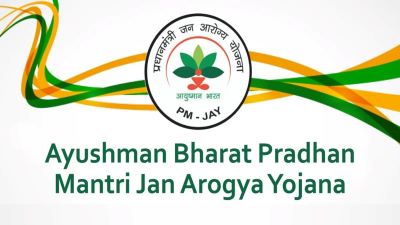Context-
The Pradhan Mantri Jan Arogya Yojana (PMJAY) is a crucial component of Ayushman Bharat, India's initiative for universal health coverage (UHC). Launched in 2018, PMJAY aims to provide significant health coverage to over 12 crore economically vulnerable families in India. However, recent challenges, including delayed payments to hospitals and reported cases of facilities turning away PMJAY patients, raise questions about the sustainability and effectiveness of the scheme. In this discussion, experts look into the need for a potential design change to enhance PMJAY's efficacy.
What is Ayushman Bharat-PMJAY?
● Ayushman Bharat-Pradhan Mantri Jan Arogya Yojana (PMJAY) is the world's largest government-funded health insurance scheme. Launched in 2018, it provides a comprehensive health coverage of up to Rs. 5 lakh per family for both secondary and tertiary care services. The scheme encompasses various Health Benefit Packages, including coverage for surgeries, medical treatments, day care procedures, as well as the expenses for medicines and diagnostics.
● PMJAY operates as an entitlement-based initiative, primarily targeting beneficiaries identified through the latest Socio-Economic Caste Census (SECC) data. However, the National Health Authority (NHA) allows flexibility for States/Union Territories (UTs) to utilize alternative beneficiary family databases with similar socio-economic profiles for tagging against the remaining unauthenticated SECC families.
● In terms of funding, the scheme follows a shared model: 60:40 for all states and UTs with legislative bodies, 90:10 in Northeast states, Jammu and Kashmir, Himachal Pradesh, and Uttarakhand, and 100% Central funding for UTs without legislative bodies.
Assessment of Current Design
● The analysis underscores the limited scope of PMJAY, emphasizing that it only covers a fraction of total health expenditure, hovering at under 2.5%. This narrow focus on secondary and tertiary care hospitalization neglects the broader healthcare needs of the population. It is suggested that pooling government departmental expenditure with PMJAY funds could provide a more comprehensive approach towards universal health coverage, addressing not only hospitalization but also outpatient care, diagnostics, and drug coverage. This, it's believed, would optimize resource allocation and improve overall healthcare accessibility.
● There's acknowledgment of the predominant preference for private hospitals over public ones due to perceived quality disparities. However, the strain on private facilities, including capacity constraints, payment delays, claim rejections, and capped treatment costs imposed by the government, is also highlighted. The critical role of strengthening the public sector to alleviate the burden on private providers and enhance overall healthcare accessibility remains a key concern.
Performance Disparity Among States
● Significant variations in PMJAY performance across states are highlighted, with instances of inactive empanelled hospitals and delays in claim payments. These disparities are attributed to governance processes and capacity constraints, particularly in states with inadequate healthcare infrastructure. The importance of network adequacy is emphasized, with regions lacking sufficient hospital capacity struggling to effectively implement PMJAY, leading to disparities in coverage and service delivery.
● The need for targeted interventions to strengthen public healthcare delivery systems, including investments in infrastructure, human resources, and governance mechanisms, is underscored.
Role of Public Sector Strengthening
● It's argued that the public sector must lead efforts to address healthcare deficiencies in underserved regions, as the private sector may be reluctant to invest in such areas. Leveraging the public sector's purchasing power through a purchaser-provider split could improve healthcare accessibility, especially in poorer states. Aligning PMJAY with broader government healthcare expenditures could address disparities and enhance coverage in regions with limited infrastructure.
Addressing Out-of-Pocket Expenditure
● Expanding Coverage Beyond Inpatient Care: Challenging the notion that PMJAY and health and wellness centers alone can address India's healthcare challenges, there's a call to expand coverage to outpatient care, diagnostics, and drug coverage. Fragmenting the healthcare landscape with separate insurance schemes is discouraged, advocating for a unified approach to reduce out-of-pocket expenditure. While PMJAY mitigates inpatient treatment costs, it's suggested that it falls short of comprehensive coverage, particularly for outpatient services. Integrating outpatient care and preventive services into PMJAY is recommended to address the root causes of illness and reduce the need for costly hospitalizations.
● Examining Alternative Models: Consideration of alternative healthcare financing models is encouraged, citing successful examples from states like Tamil Nadu and Rajasthan, which prioritize free medicines and universal healthcare initiatives. However, acknowledging the fiscal constraints and limitations of PMJAY's current model, there's a suggestion to integrate the insurance model with broader public sector initiatives to achieve the desired outcomes. Piloting innovative payment models that incentivize quality and efficiency in healthcare delivery, such as bundled payments and capitation arrangements, is proposed. A holistic approach to healthcare financing, encompassing both insurance coverage and investments in public health infrastructure and services, is emphasized.
Conclusion
In conclusion, the discussion underscores the need for a nuanced approach to enhance PMJAY's effectiveness and sustainability. Experts advocate for strengthening the public sector, addressing capacity constraints, and integrating PMJAY with broader government healthcare expenditures to achieve universal health coverage. While challenges persist, the consensus remains that a comprehensive strategy, focusing on both supply and demand-side factors, is essential to address India's healthcare disparities and reduce out-of-pocket expenditure.
|
Probable Questions for UPSC Mains Exam- 1. How can the Pradhan Mantri Jan Arogya Yojana (PMJAY) be redesigned to address the limitations in its current scope and ensure comprehensive universal health coverage for all beneficiaries? ( 10 Marks, 150 Words) 2. What strategies can be implemented to reduce the performance disparities among states in the implementation of PMJAY and ensure equitable access to healthcare services across regions? ( 15 Marks, 250 Words) |
Source- The Hindu







